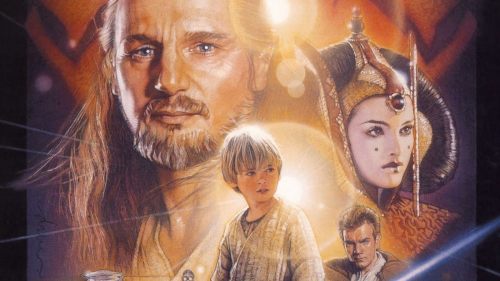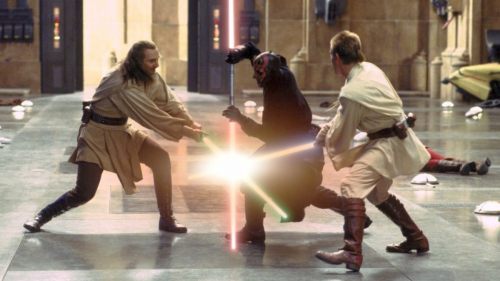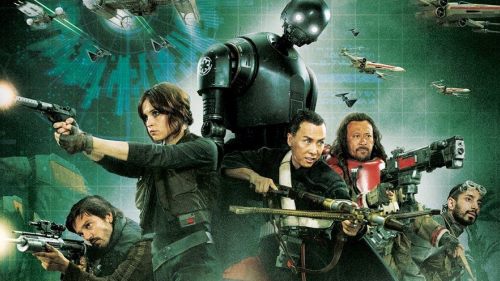The Unsung Praises of THE PHANTOM MENACE
Rogue One is almost here! We're doing a bunch of articles to help celebrate and get pumped up for the new movie. You can buy tickets here!
Star Wars Episode I: The Phantom Menace is remembered by many as a betrayal of the virtues that had guided the original Star Wars films to artistic perfection. It was too juvenile for adults and too patronizing for children. It abandoned the durable charm of practical special effects for lifeless, disposable computer animation.
How easily we forget that in their time, the puppets and miniatures of the original trilogy were not quaint traditions but cutting-edge technology, and that A New Hope itself challenged prevailing ideas about the division of adult and children's entertainment. With The Phantom Menace, George Lucas did what he had always set out to to do: Push the limits of movie technology and blur the boundaries of audience and genre. Just as the original Star Wars films celebrated a range of classic entertainment with new technology and a startling new style, so was The Phantom Menace guided not merely by complacent satisfaction with what had come before but also new ideas and new approaches.
The Phantom Menace features an abundance of imaginative settings, all of them in the style and spirit of Star Wars but new to the franchise's repertoire. The capitol of Naboo is an alien fantasia of old Europe, all mossy stone, domes of oxidized copper, and towering heroic statues. The Trade Federation's march toward Queen Amidala's palace recalls the Nazi invasion of France, continuing the franchise's visual relationship to World War II. The underwater Gunga City is a Jules Verne-like mass of glowing glass orbs encased in florid metalwork. The massive skyscrapers of Coruscant reach over an endless sea of light, and the Galactic Senate is a massive school of floating box seats. The film luxuriates deservedly in its exotic scenery.
Likewise, the ships of The Phantom Menace borrow from real life and science fiction's past to create something totally original. The Naboo Fighter and Queen Amidala's Royal Starship combine the slick, shiny surfaces and curvaceous contours of pulp sci-fi rockets with nautical influences (appropriately enough for the water-filled planet). The Naboo ships are long and tapered, but also wide and flat. Even the Trade Federation's ships and tanks feature rounded silhouettes.
George Lucas clearly wanted what was to be the new official beginning of the Star Wars saga to be more accessible to younger viewers. To the astonishment of older fans, this was not a futile strategy. "He loved Anakin," said Vulture's Bilge Ebiri of showing The Phantom Menace to his young son. "Who was this strange kid who loved The Phantom Menace so much!?"
In addition to a younger protagonist, The Phantom Menace featured gentler antagonists, the Battle Droids. There is a soft edge to the threat of the Stormtroopers; their aim is abysmal when their blasters aren't set to "stun." But the Battle Droids dial down the intensity a bit more. The stakes of their action scenes are lower, as the Droids can be hacked to pieces without anyone really getting hurt. The Battle Droids are also infused with the innocence of Star Wars robots, chirping "Roger, roger!" to each other as they march about and stammering "Does not compute" when faced with an enemy bold enough to disobey them.
Although it features franchise staples like an invading army, The Phantom Menace also finds excitement outside the theater of battle. One of the film's most thrilling and imaginative set pieces does not concern combat but sport: the Pod Race. With the same genre-blending skill that established the original trilogy's rich mixture of science fiction, fantasy, war, western and samurai movies, George Lucas reached confidently for Ben-Hur and gave The Phantom Menace its own story of a slave winning their freedom in a chariot race.
The Boonta Eve Classic is a signature Star Wars moment, seamlessly mixing opposing film genres with details from our own world, as this primitive sport performed with advanced technology is narrated by NASCAR-like commentary from a two-headed alien announcer. It is a testament to the inspiration of these choices that for all the purity tests applied to the Star Wars prequels and the many elements dismissed, the conceptual validity of aliens racing chariots pulled by massive floating engines is seldom challenged.
The Pod Race involves another common bone of contention, the character of master Jedi Qui-Gon Jinn. Qui-Gon is commonly derided as a cipher and cad, a non-character who tricks Anakin's owner Watto into releasing him in a crooked bet. But Qui-Gon is not cheating a cheater as much as teaching Watto a lesson about the danger of greed. Expecting to win, Watto agrees every time Qui-Gon raises the stakes of their wager. Meanwhile, Qui-Gon's success depends on Anakin, who not only wins the race honestly, but overcomes the sabotage of rival racer Sebulba.
It is by now obligatory in the genre of Phantom Menace criticism to note the presence of racial stereotypes, and let us not ignore them. But at the same time, let us not regard such insensitivity as a new problem for Lucas. Even the original trilogy featured the Arab-like Tusken Raiders (originally just called "Sand People") and the man-eating pygmy Ewoks. Star Wars has always mined the entertainment of George Lucas's childhood with little consideration for its historical context, and this has yet to extinguish the notion that Star Wars can become an effective advocate for diversity going forward.
For better and worse, The Phantom Menace is true to the revolutionary spirit in which the original Star Wars trilogy was conceived. It used the most powerful technology available to weave what had come before it into a fascinating new form. Its daring and originality is ripe for appreciation. You can reject it if you want, but like Watto, in the end you're only cheating yourself.



